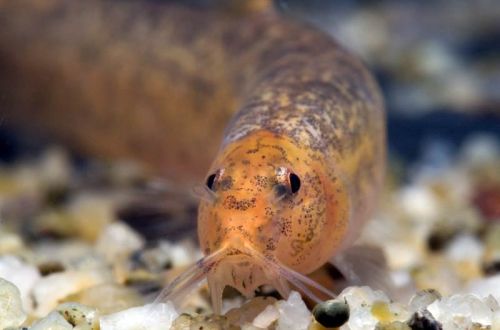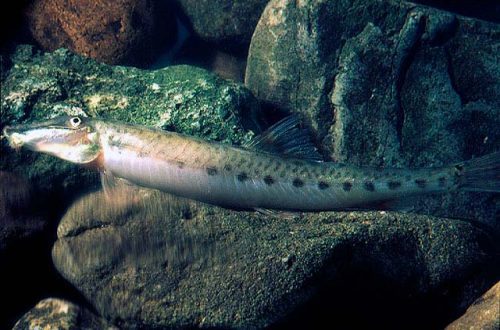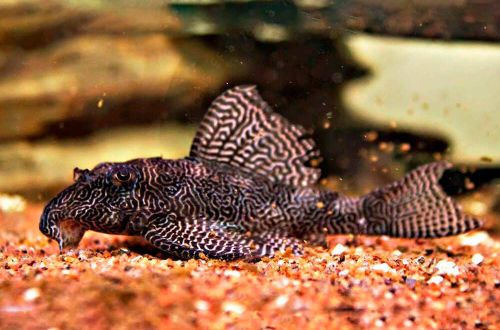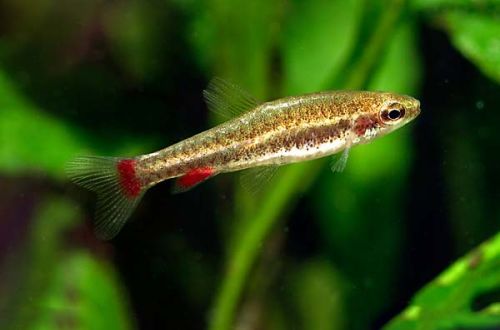
Sausage fish
Sausage char or Sausage fish, scientific name Lepidocephalichthys tomaculum, belongs to the family Cobitidae (Loaches or Loaches). Such a playful name of the fish even entered the Latin name, the word tomaculum just translates as “sausage”. It seemed to scientists that with its elongated cylindrical body shape, this species resembles the corresponding food product.

Contents
Habitat
It comes from Southeast Asia, inhabits numerous river systems in the territory of Peninsular Malaysia. Prefers regions with a slow current or stagnant backwaters, swamps. A typical biotope is a reservoir, the bottom of which is covered with a layer of fallen leaves interspersed with numerous snags and tree roots. The water level changes depending on the season. During the rainy season, the coastal zone of tropical forests is flooded, where all aquatic inhabitants rush in search of food. In the dry season, it is not uncommon for the water level to drop so much that the reservoirs turn into small puddles, rapidly blooming with algae.
Brief information:
- The volume of the aquarium – from 40 liters.
- Temperature – 23-29°C
- Value pH — 3.5–7.0
- Water hardness – soft (1-10 dGH)
- Substrate type – soft sandy
- Lighting – subdued
- Brackish water – no
- Water movement – moderate
- The size of the fish is about 4 cm.
- Nutrition – protein-rich food, sinking
- Temperament – peaceful
- Content in a group of 4 individuals
Description
Adult individuals reach a length of about 4 cm. The body is elongated cylindrical in shape, outwardly resembles an eel. The head is small, there are three pairs of antennae near the mouth, with the help of which the fish searches for food in a layer of silt / sand. The coloration is orange or sandy with brown markings all over the body. The fins and tail are short, rounded and translucent.
In nature, Loach-sausage often finds itself in semi-dried reservoirs, therefore, in the process of evolution, it developed an additional way of breathing by swallowing a portion of atmospheric air and extracting oxygen from it in a special section of the intestine.
Food
The main method of feeding is sifting the soil with the mouth in search of small invertebrates. In the home aquarium, you should feed sinking flakes and pellets with a high protein content, as well as fresh and frozen foods such as brine shrimp, bloodworms, daphnia, etc.
Maintenance and care, arrangement of the aquarium
The optimal size of the aquarium for a group of 4 fish starts from 40 liters. In view of the nutritional characteristics of Sausage Fish, the substrate acquires key importance in the design. It is necessary to use sandy or fine gravel soil without sharp edges to avoid damage to the gills through which the sifting occurs. You should also provide several shelters at the bottom, for example, natural snags, thickets of plants, or decorative objects. The fish prefers a subdued level of lighting. Additional shading can be arranged with floating plants.
Another important factor in long-term maintenance is the quality (absence of pollution) and the hydrochemical composition of the water. To this end, regular maintenance of the aquarium is carried out, in particular: weekly replacement of part of the water with fresh water, removal of organic waste, prevention of water purification equipment. Although this species is able to tolerate large fluctuations in pH and dGH, the sudden spikes that can occur during a partial water change should not be tolerated.
In general, this is an easy fish to keep and maintenance procedures are similar to most other freshwater species.
Behavior and Compatibility
The sausage char has a peaceful, calm disposition, gets along well with relatives and other non-aggressive and non-territorial fish. Good neighbors will be species that live in the water column or near the surface.
Fish diseases
Finding the fish in a suitable habitat, getting them a balanced diet and free from external threats such as attacks from tankmates is the best guarantee against disease. The appearance of signs of illness can be a signal that there are problems in the content. Usually, bringing the habitat back to normal contributes to self-healing, but if the body of the fish has suffered too much, then medical treatment will be required. Read more about symptoms and treatments in the Aquarium Fish Diseases section.





